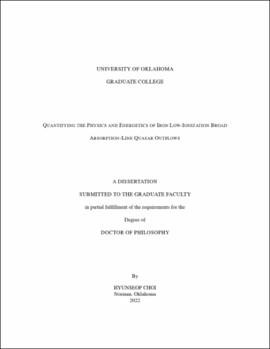| dc.contributor.advisor | Leighly, Karen | |
| dc.contributor.author | Choi, Hyunseop | |
| dc.date.accessioned | 2022-10-06T18:07:40Z | |
| dc.date.available | 2022-10-06T18:07:40Z | |
| dc.date.issued | 2022 | |
| dc.identifier.uri | https://hdl.handle.net/11244/336535 | |
| dc.description.abstract | Quasars are among the most luminous and massive objects in the universe. They host an actively accreting supermassive black hole (SMBH) at their centre that can power energetic phenomena that outshine the host galaxy. A substantial fraction (∼ 20 − 40%) of quasars show broad absorption-line (BAL) features in their rest-ultraviolet (UV) spectra that show clear evidence for powerful outflows originating from the central SMBHs. These outflows can carry a significant amount of energy and mass from the central SMBHs to their host galaxies. Therefore, BAL quasars are prime targets for investigating luminous quasar feedback on galaxies by which the star formation rate and the evolution of the host galaxies are thought to be controlled.
SimBAL provides a novel method to study the complicated spectra of BAL quasars. Tens of thousands of BAL quasar spectra available in public archives were assumed to be impossible to analyze for more than five decades. The spectral synthesis code SimBAL our group developed can analyze even the most heavily absorbed BAL quasar spectra and provide constraints on the physical properties of the outflow as a function of velocity. Using this software, I discovered the most powerful BAL quasar outflow analyzed to date in SDSS J135246.37+423923.5. The spectral analysis showed that the outflow has the velocities reaching ∼ −38000 km/s and the outflowing gas is located near the dusty torus at ∼ 10 pc from the central SMBH. The outflow has the log kinetic luminosity log LKE ∼ 48.1 [erg/s] which exceeds the bolometric luminosity of the quasar and is energetic enough to power feedback.
I performed the first systematic study of a large sample of low-redshift iron low- ionization broad absorption-line (FeLoBAL) quasars and characterized the general properties of the FeLoBAL outflows. The SimBAL analysis of 50 FeLoBAL quasar spectra revealed that the FeLoBAL gas is located at a wide range of distances (0 ≲ log R ≲ 4.4 [pc]) and has a wide range of physical properties. We discovered a new type of FeLoBAL quasar, loitering outflow objects, that are characterized by low outflow velocities and high column density winds located at log R ≲ 1 [pc] from the central SMBH. Finally, I used SimBAL to analyze a spectroscopic variability for J164653.72+243942.2 that showed a variable BAL features from an extremely-high velocity outflow (v ∼ 0.17c).
The series of work presented in this dissertation demonstrates only a small fraction of scientific discoveries that can be made with SimBAL. I briefly summarize the results from the series of publications led by SimBAL collaboration that make use of the properties of the low-redshift FeLoBAL quasar outflows constrained from the SimBAL analysis. Finally, some of the planned future work using SimBAL is outlined. | en_US |
| dc.language | en_US | en_US |
| dc.rights | Attribution-NonCommercial 4.0 International | * |
| dc.rights.uri | https://creativecommons.org/licenses/by-nc/4.0/ | * |
| dc.subject | Physics, Astronomy and Astrophysics. | en_US |
| dc.subject | Broad-absorption line quasar | en_US |
| dc.subject | Active galactic nuclei | en_US |
| dc.title | Quantifying the Physics and Energetics of Iron Low-Ionization Broad Absorption-Line Quasar Outflows | en_US |
| dc.contributor.committeeMember | Gutierrez, Phillip | |
| dc.contributor.committeeMember | Kornelson, Keri | |
| dc.contributor.committeeMember | Mason, Bruce | |
| dc.contributor.committeeMember | Morabito, Leah | |
| dc.contributor.committeeMember | Terndrup, Donald | |
| dc.date.manuscript | 2022 | |
| dc.thesis.degree | Ph.D. | en_US |
| ou.group | Dodge Family College of Arts and Sciences::Homer L. Dodge Department of Physics and Astronomy | en_US |
| shareok.orcid | 0000-0002-3173-1098 | en_US |

